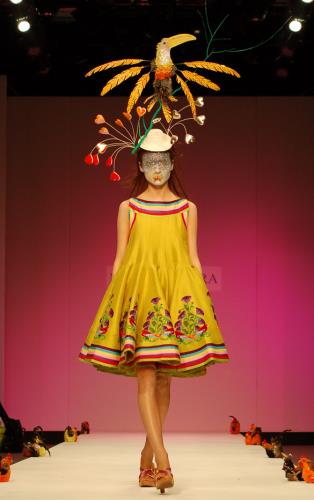Yap loves design, travel and everything beautiful in life. He writes for various media about travel and design and has published works, including Wander Bhutan and Myanmar Odyssey. Formerly publisher of Lonely Planet (China Office), Yap is now Chief Content Officer of Youpu Apps, a Beijing based travel app company.

Manish Arora’s design Photo courtesy of Rebecca Cotton
“India” is not only a noun but can also be used as an adjective. Walking on the streets in India, the colours that are so “India” can really stimulate and excite visitors. There are no places like India that is so good at using colours. People normally avoid using contrasting colours. For example, it’s very rare to match pink with yellow. But in India, complementary colours are commonplace.
India is a breeding ground of creativity as it has diversified cultures. Hinduism boasts a variety of gods and deities and each of them has his or her own duties. This perhaps can tell that Indian people are very receptive to new ideas. While British people brought the English language to India, people in India have made clever use of the language and even composed a number of English literature.
Design is one of the derivatives of innovation. India has had no shortage of designers and good designs. One thousand years ago, the rulers of Khajuraho designed a number of erotic sculptures and added them to a group of holy temples. The grieving king of Agra designed a white architecture in the memory of his beloved wife. The symmetrical structure is simplistic in style, yet the details are intricate.
When the British people arrived in India, they added a number of grand buildings and developed New Delhi. They had ruled this country for almost 200 years. The cities of Delhi, Calcutta and Bombay are all filled with western architecture.
Arrived in the cradle of civilisation, the British didn’t make thoughtless decisions as to how to deal with this country. Instead, they showed their respect to it. Transporting millions of people every day, the Victoria Terminus Station looks like a Gothic church. I looked into the details of the structure in this over-crowded station and discovered that the interior is supported by steel columns with elaborate carvings. The exterior boasts splendid arches, turrets and a dome, all of which look more European than any designs in Europe. But when you take a closer look to the details, you will discover that on the edge of the corridors and on the surface of the stony beams, there are lots of Indian-style decorations. Peacocks and monkeys are among the many creatures decorating the colonial building and they showcase the unique style of flamboyance and splendour in India.
Indian style has become a fountain of inspirations for designers all over the world. An observer specialising in design once said that without inspirations from India, John Galliano would find it difficult to do what he wants to do. It’s so true that India has become western designers’ muse.
Like any other Asian designers, Indian designers also start from the traditional cultures of their own first and try to marry modern and traditional designs. This is especially the case when it comes to haute couture designers. They tend to specisalise in designing wedding gowns and evening dresses with elaborate and flamboyant details and styles. In the fashion industry in today’s India, it’s not difficult to notice that most emerging designers come from a similar background. They are educated in top colleges overseas and have done internships with famous designers. They understand how design and marketing can work together. These designers tend to have their bases in big cities. Bombay and Delhi are top choices because these cities are wealthier and consumers are more open-minded.
I particularly like the designs by Rajesh Pratap Singh. He is very low-profile and reluctant to be interviewed. His designs really reflect his personality. Apart from simple lines and cuts, he added discreet ornaments at the sleeves, giving it a classic look. He usually uses high quality fabrics produced in India as clothing materials. Hailed from Rajasthan, this emerging designer is now based in Delhi and has five stores in the city. The stores are simplistic in design and feature both workwear and party dresses.
If you are not into simplicity, or if you are looking for the splendours of India, perhaps Manish Arora’s designs are more of your cup of tea. His forte is to turn a rich palette of colours and motifs to something acceptable to western buyers. He is definitely one of those designers who know how to please audiences. His creations are outlandish and quirky in shape. Plenty of beads and crystals are used for decorations. Together with the funky colours of India, his designs often wow audiences with their dramatic effects. Arora usually gets inspirations from Indian movies and deities. His designs are filled with hues of pop art with an Indian twist. Like Singh, Arora boasts a number of stores in Delhi and Bombay. Well-known fashion brands in Europe, the United States and Asia like their works and franchise his collections. Now even if you are not in India, you can still be able to buy outfits designed by him elsewhere.